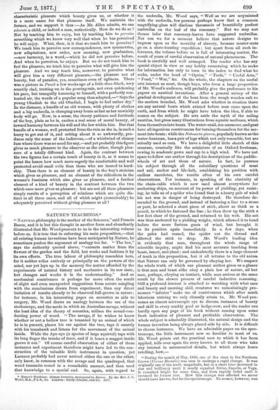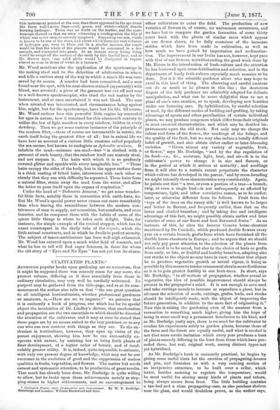NATURE'S 'TEACHINGS.*
6 6 NATURAL philosophy is the mother of the Sciences," said Francis Bacon, and it is but this thought in another form and abundantly illustrated that Mr. Wood presents to Us in the interesting volume before us. It is true that in enforcing his main proposition,—that all existing human inventions have been anticipated by Nature, he sometimes pushes the argument of analogy too far. " The bee," says the authority quoted above, " extracts matter from the flowers of the garden and the field, but works and fashions it by its own efforts. The true labour of philosophy resembles hers, for it neither relies entirely or principally on the powers of the mind, nor yet lays up in the memory the matter afforded by the experiments of natural history and mechanics in its raw state, but changes and works it in the understanding." And so mechanical contrivance is perhaps far more often the result of slight and even unexpected suggestions from nature mingling with the conclusions drawn from experiment, than any direct imitation of results already to be observed full-grown in nature; for instance, in his interesting pages on acoustics as aids to surgery, Mr. Wood draws an analogy between the use of the stethoscope, and the mode in which an Australian savage, without the least idea of the theory of acoustics, utilises the sound-con- ducting power of wood. " The savage, if he wishes to know whether or not a hollow tree is tenanted by an animal of which be is in pursuit, places his ear against the tree, taps it smartly with his tomahawk and listens for the movement of the animal inside. While the Aye-aye (a species of large squirrel) taps with its long finger the trunks of trees, and if it hears a maggot inside gnaws it out." Of course careful observation of either of these instances and experiment therefrom might have led to the con- struction of the valuable little instrument in question, yet Laennec probably had never noticed either the one or the other, only knew, in common with the savage and the quadruped, that wood transmits sound in a remarkable manner, and then used that knowledge to a special end. So, again, with regard to * Nature's Teachings: Human Invention Anticipated be Nature. By the Bev. J. G. Wood, ILA., F.L.S., &e. London: Daldy, Waster, and Co. 1877.
the umbrella, Mr. Wood says, " Well as we are acquainted' with the umbrella, few persons perhaps know that a common magnifying-glass will disclose thousands of beautifully perfect umbrellas on the leaf of the rosemary." But we may not
thence infer that rosemary-leaves have suggested umbrellas. Nor can we for a moment believe that nature designs to impress upon us the morality of slavery, because master-ants- go on a slave-hunting expedition ; but apart from all such in- ferences, the volume before us is full of interesting matter, the result of years of careful observation of natural phenomena. The
is carefully and well arranged. The reader who has any special object in view or any hobby concerning which he seeks- for information has only to turn to the index to find what he seeks, under the head of " Optics," " Tools," " Useful Arts," "Food," " War," &c. On the whole, the chapters on the useful arts interest us most, though boys, who form a large proportion of Mr. Wood's audience, will probably give the preference to his- papers on nautical inventions. After a general survey of the- gradual development of the boat from the rough wooden raft to the modern ironclad, Mr. Wood asks whether in creation there- are any natural boats which existed before man came upon the earth, and from which ho might have taken the idea, if able to reason on the subject. He sets aside the myth of the sailing' nautilus, but gives many illustrations from aquatic molluscs, which form themselves into boats. The water-snail, sea-anemone, and gnat have all ingenious contrivances for turning themselves for the mo- ment into boats; while the Notonecta glauca, popularly known as the- water-boatman, has a pair of legs which not only resemble, but are actually used as oars. We have a delightful little sketch of this- creature, comically like the miniature of an Oxford freshman, rowing in academic gown and cap in a high wind. We have not space to follow our author through his descriptions of the paddle- wheels of art and those of nature. In fact, he pursues. his subject through all the subsidiary questions of mast and sail, anchor and life-belt, establishing his position with endless anecdotes, the results often of his own careful observations. For instance, in speaking of the elasticity of the chain-cable which is now used almost everywhere for anchoring ships, on account of its power of yielding, yet resist- ing, he tells us of a spider who found that in a heavy gale of winds his net was in danger of being destroyed. He therefore de- scended to the ground, and instead of fastening a line to a stone or post, he selected a short piece of stick, about as thick as a. pencil, to which he fastened the line ; he then drew up the stick a few feet clear of the ground, and returned to his web. His net was thus anchored by a yielding weight, which allowed it to bend before the more furious gusts of wind, but brought it to its position again immediately. In a few days, when the gales had ceased, the spider cut the thread and allowed the stick to drop. Mr. Wood's leading idea is evidently that man, throughout the whole range of scientific inquiry, might find his most accurate teaching from beast, insect, and plant ; and undoubtedly there is a large element of truth in this proposition, but it all returns to the old axiom that Nature can only be governed by obeying her. We suspect the whole truth of which our pleasant author gives us a glance- is that man and beast alike obey a plain law of nature, all but man, perhaps, obeying an instinct, while man arrives at the same result by the slower process of careful inductive reasoning.. Still a profound interest is attached to watching with what ease and beauty and unerring skill, creatures we unhesitatingly pro- nounce " inferior " make use of contrivances which after much
laborious striving we only clumsily attain to. Mr. Wood pos- sesses an almost microscopic eye to discern instances of beauty-
and skill in every muddy pool or hedge-row, and the reader cam hardly open any page of his book without coming upon some fresh indication of pleasant and profitable observation. The whole subject is admirably illustrated, the natural design and the human invention being always placed side by side. It is difficult to choose instances. We have an admirable paper on the spec- troscope, the little instrument now so familiar to most of us. Mr. Wood points out the practical uses to which it has been applied, tells over again the story known to all those who take any interest in astronomical details, but which always bears retelling, how,—
" Daring the month of May, 1866, one of the stars in the Northern Crown (Corona Borealis) was seen to undergo a rapid change. It was- originally one of the tenth magnitude, but in a short time increased in size and brilliancy until it nearly equalled Sirius, Capella, or Vega. It remained bright for some time, and then rapidly faded until it resumed its former size. How this change was effected we never should have known, but for the spectroscope. No Homer, however, was. this instrument pointed at the star, than there appeared in the spectrum 'the three well-known lines—red, green, and violet--which denote burning hydroger. There was no doubt on the matter, and the spec- troscope showed us that we were witnessing a conflagration the like of which was never seen, or scarcely imagined. Supposing our sun, which is known to be one of the stars, and about which there are vast volumes of hydrogen gas, were to blaze out in a similar manner, the result would be that the whole of the planets would be consumed in a few seconds, and converted into gases. In an instant every living thing would bo swept off the surface of the earth by this fearful beat, and as Mr. Roscoe says, our solid globe would be dissipated in vapour almost as soon as drops of water in a furnace?"
Mr. Wood mentions also the application of the spectroscope in the making steel and to the detection of adulteration in wines, and tells a curious story of the way in which a man's life was once
saved by its means. A murder had been committed, and a man found near the spot, with his coat-sleeves stained (apparently) with blood, was arrested ; a piece of the garment was cut off and sent to a well-known spectroscopist, who tried the red matter by the
instrument, and at once ascertained it was not blood. The man when arrested was intoxicated, and circumstances being against him, might, but for the spectroscope, have lost his life. Of course, Mr. Wood notices bow this powerful little engine lay concealed for ages in nature, how it remained for this nineteenth century to utilise the law of light manifest in every rainbow, hidden in every dewdrop. Then we get some curious instances of the principle of 'the modern filter,—these of course are innumerable in nature, the earth itself being the greatest filter of all ; but in animal life we Lave here an account of a curious little creature called popularly
the sea-mouse, but known to as Aphrodite acukata. It inhabits the mud—noisome sea-mud—but• "is clothed with a garment of such beauty, that the rainbow itself can scarcely rival, and not surpass it. The hairs with which it is so profusely covered glitter and sparkle with every imaginable hue." "These Lairs occupy the sides of the body, but in the upper surface there is a thick coating of felted hairs, interwoven with each other so closely that they can with difficulty be separated. These hairs form a natural filter, strain away the mud from the water, and allow the latter to pour itself upon the organs of respiration."
Under the head of " Defensive Armour," we get some wonder- ful little facts, notably those in connection with earth-forts, &c.
But Mr. Wood's special power never comes out more remarkably than when tracing the resemblance between the modern con- trivances of man to supply, not necessities, but comforts, and even luxuries, and he compares these with the habits of some of the queer little things in whom he takes such delight. Take, for instance, the simple example of the conical stopper, which has its exact counterpart in the shelly tube of the serpula, which the little animal constructs, and in which he dwells in perfect security. The subject of insect-architecture has been well-nigh exhausted. Mr. Wood has entered upon a much wider field of research, and what he has to tell will find eager listeners, in those for whom the old story of " Eyes and No Eyes " has not yet lost its charm.



































 Previous page
Previous page